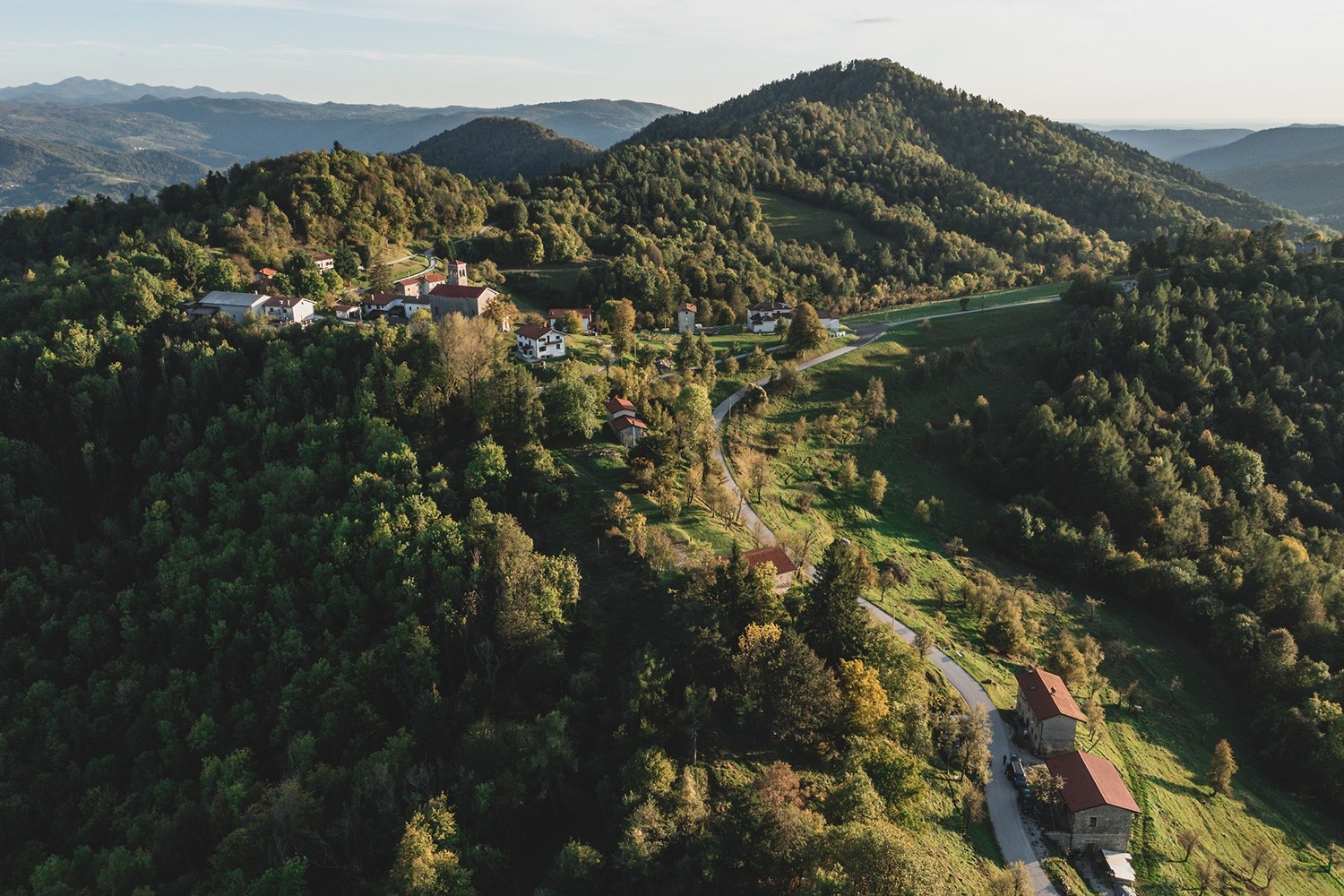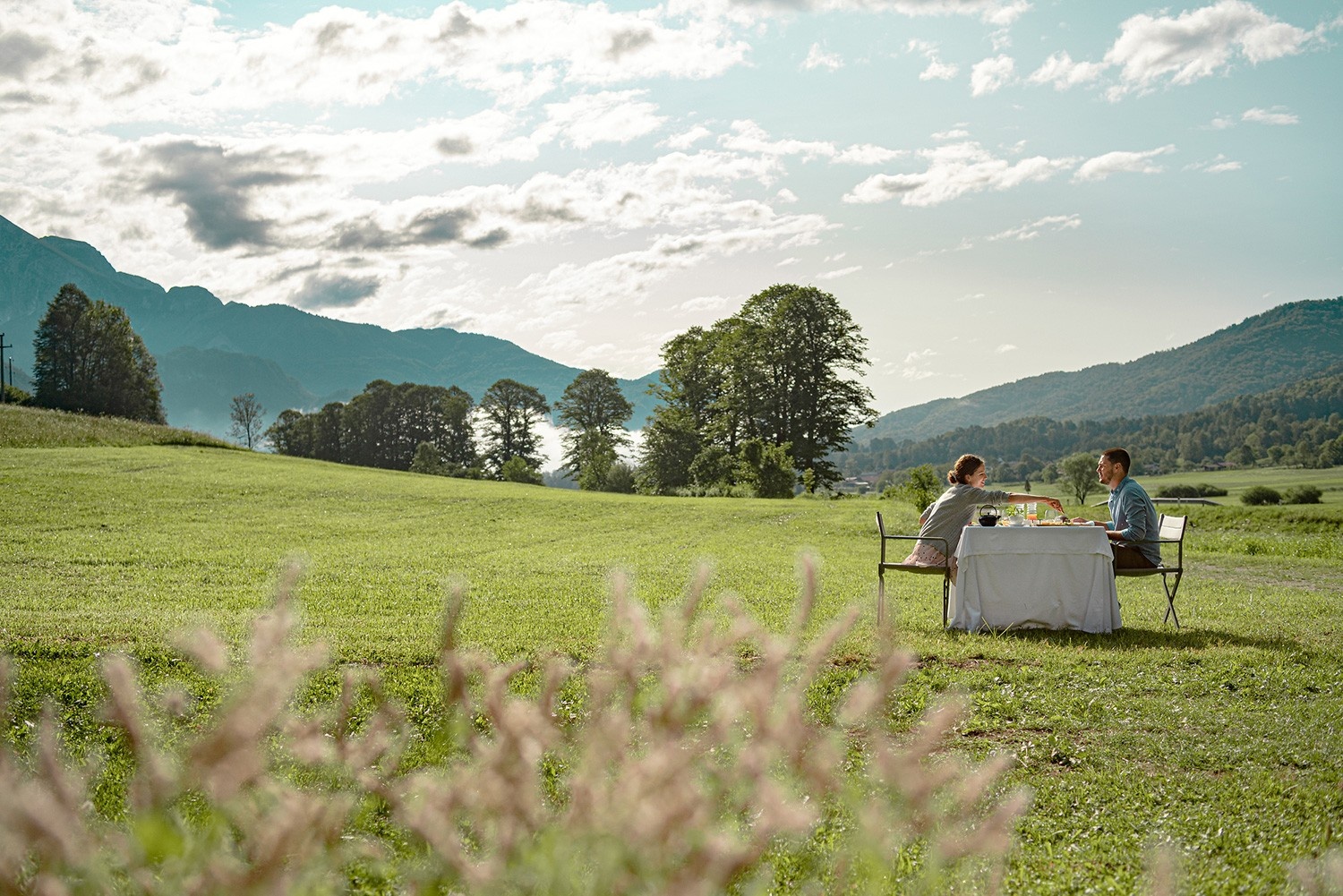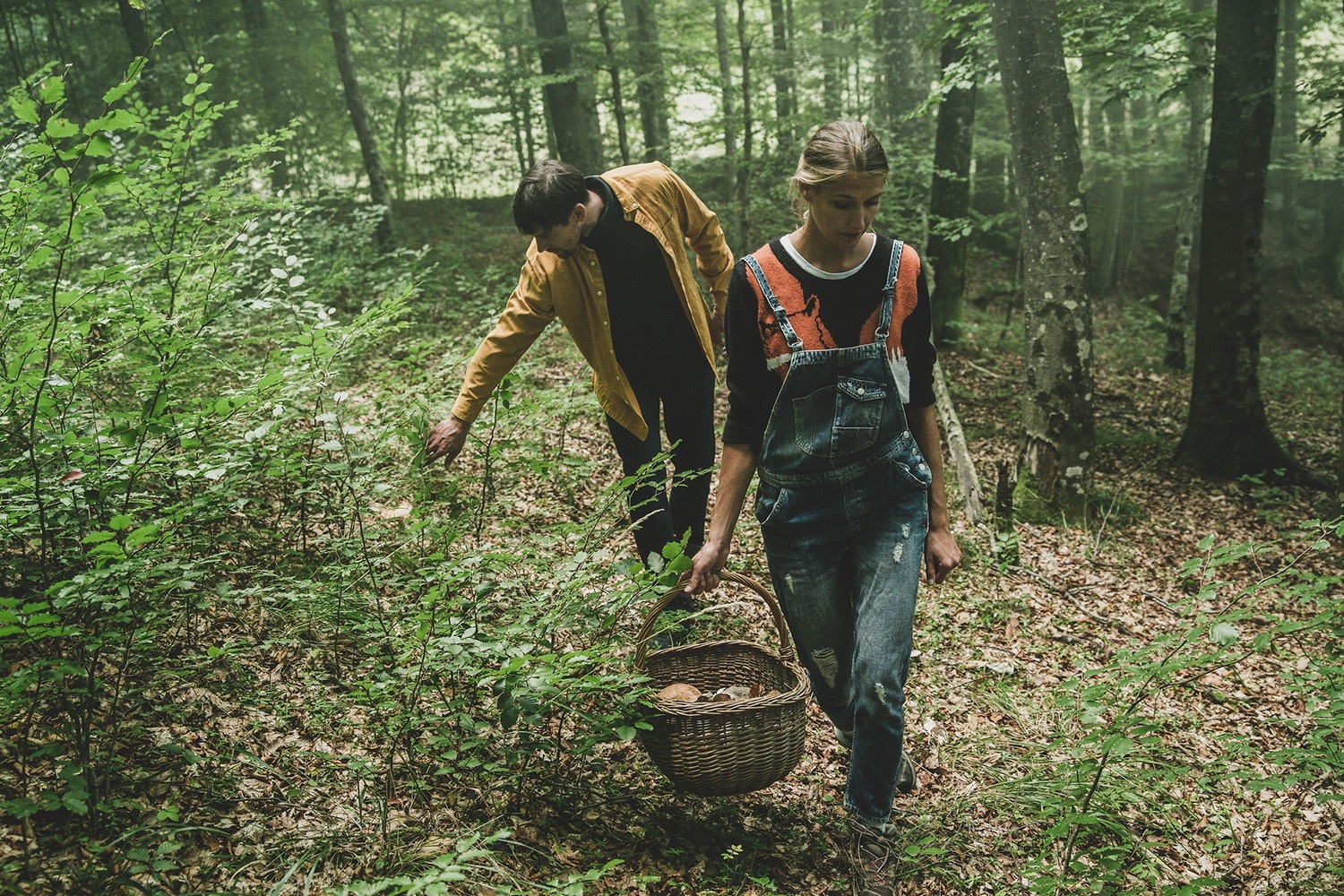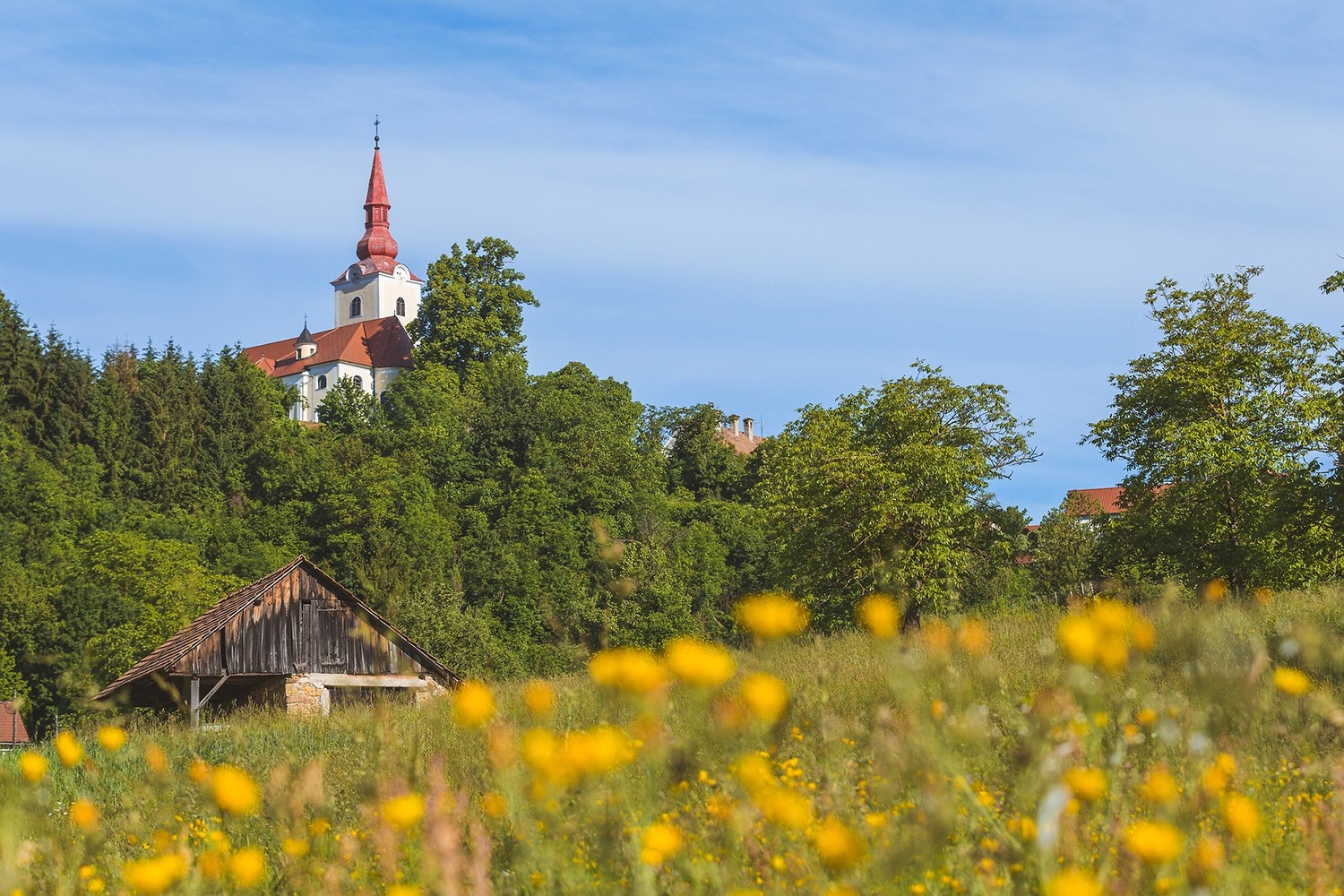NORTH STARS:
Production Consumption
Community Support
Carbon Footprint
“This is simply how our ancestors lived — making the most of their surroundings.”
I step over the web of entangled roots to reach a clear opening in the forest, towering trees surrounding us on every side. In front of me stands a rickety table and chairs with a glass jug on top. The sun peeks through, illuminating the ingredients swimming lazily in the water. Best known as a wild plant collector and cultivator in these parts, Lovro Vehovar hands me the first sip. I almost choke in excitement as I learn the floral notes I’m tasting were handpicked just this morning in the back garden.
Foraging has long been a part of rural life — whether for wild herbs, mushrooms, berries, or edible plants. Today, i’ts making a comeback, especially among young people, chefs, and eco-conscious individuals.

Slovenia_s forests are treasure troves of edible wild foods. Courtesy of Ciril Jazbec for the Slovenian Tourist Board.
Wild Ingredients and Foraged Flavors
From the alpine regions to the Mediterranean Coast, Slovenia’s diverse climate zones and rolling hills allow for a variety of crops to be grown, from wheat and corn to grapes for wine. But outside agriculture, plenty grows wild in the hills, fields, and forests.
My journey through the world of Slovenian foraging culture starts in an off-grid hut made of mud and straw in the eastern part of the country. I’m at the home of Monika and Lovro Vehovar — a living estate in the middle of the forest. Here, the ethnologist and anthropologist and biologist and herbalist duo run Korina Herbs.
Wandering through their wild garden, I see growing fruits mingling with medicinal plants and mushrooms, and wildlife galavanting freely in the fields. Through their extensive knowledge, the couple educate people about local plants through workshops on their estate, but they’re also a key supplier for many regional chefs.

Across the Slovenian countryside, foraging is flourishing. Courtesy of Slovenian Tourist Board.
Sourcing Locally in Eastern Slovenia
One of the chefs with whom Lovro works is Bine Volcic. Volcic, along with his wife Katarina, run Monstera Estate, a homestay and restaurant in the Goricko Hills. Relaxing with a glass of wine on the back patio, I immediately understand why the couple relocated to this serene setting from the bustling city. Cascading green hills and fruit trees surround the estate in all directions, and the unmistakable whiff of cooking emanates from the kitchen.
People come to this remote culinary haven for its food and beverage program, where Bine prepares locally-inspired tasting menus paired with fine wines. Clearly in his element, I see him at the helm of the kitchen, guiding his sous chefs through the menu. “I believe that the genuine taste comes from nature, whether it’s foraged ingredients or from carefully produced foods in the form of organic ingredients,” he says. Between dishes and tasting notes, he joins us with his guitar for a sing-along. I feel completely at home in their presence.
Dish after dish appears at the table, all created with local products. From a delicate wafer that looks like a leaf, to fish bones that taste like a crisp, the use illusion leave me in awe with each bite. My eyes see one thing, but my taste buds experience something different altogether.
To complement produce from Lovro’s garden and estate, Bine and his wife forage. “We love it: from ramsons leaves and flower buds to wild herbs, dandelion, elderflower and acacia, mushrooms and kitchen,” he says. Hand-picked flavors brighten and enlighten Bine’s cooking, each dish topped with herbs and edible flowers.

Outdoor dining on Slovenia_s outdoor flavors. Courtesy of Slovenian Tourist Board.
More Than 500 Years of Recipes
Two hours away and closer to Ljubljana, sits an unassuming yellow building with colorful flower boxes lining the windows. A family home for more than 500 years, it’s now a restaurant called Gostilna Repovž. Here, sourcing from surrounding lands was the norm and passed on through generations.
“Our inn and family have a tradition spanning several hundred years, and a strong connection with nature is not something new or trendy for us. This is simply how our ancestors lived — making the most of their surroundings — and today, we continue this approach, perhaps with even greater respect for nature and sustainability,” says CEO Grega Repovž.
Strongly rooted in Slovenian culture, the most common form of foraging that springs to mind for tourists is mushrooms. So of course, this is what I expected to find on the menu. But Gostilna Repovž goes much further. “We work with an endless variety of natural ingredients, from wild herbs and edible flowers to preserved and fermented elements that allow us to extend the seasons,” he says.
Modernizing Family-Recipes
Continuing our journey through Eastern Slovenia, we make our way to the family-owned Rajh Restaurant, another wilderness-to-plate establishment. Before the meal, mother-son duo Tanja Pintarič and Leon Pintarič emerge from the confines of the kitchen to share more about their mission to serve high-end Slovenian foods with a contemporary twist. One example is Rajh’s Langos: a traditional fried flatbread topped with yogurt, chives, grated smoked ham, horseradish and hemp seeds.
“A key element in incorporating natural ingredients into our menus is finding ways to elevate their flavors without overpowering them,” says Tanja. “In essence, keeping them as close to their original form as possible.” Methods used include a quick pickle, a subtle garnish, or the creation of a pumpkin seed butter.
Produce changes with the season, whether mushrooms and wild garlic in March, to asparagus, elderberry flowers, and fresh strawberries and apricots, come spring and summer.
I’m visiting in May. Cucumbers are breaded with a yogurt dip, and mushrooms are presented in a type of paste layered atop a thin slice of bread. “We honor Slovenia’s heritage, but we also aim to push the boundaries by presenting these ingredients in new forms — whether it’s pickled, fermented, dried, or turned into powders or oils,” says Tanja.

Foraging for mushrooms in the Slovenian woods. Courtesy of Ciril Jazbec for Slovenian Tourist Board
Edible Plants and Foraged Ingredients
One of the leaders in finding applications for foraged foods in fine dining is Chef Marko Pavcnik. Owner of two restaurants in the small city of Celje and the town of Laško, Marko has been an avid forager for the last 14 years, searching for ingredients everywhere from nearby forests and meadows to the Karst plateau. He has shaped the industry, inspiring more Slovenianss to gather in their lcoal woods and pastures.
“I believe wild food is a great source of new tastes, and is packed with nutrients, and I find it gives me a lot of inspiration to develop new dishes as the seasons change,” he tells me over dinner at his restaurant Lalu. “Over the years I have worked with some experts to learn about edible plants, studied the literature and invented new ways of including wild food into my cooking.”
As we dive into the beautifully plated Štruklji topped with warmed cream, porcini mushroom sauce, oyster mushrooms, and parsley, Chef Marko disappears behind the scenes, smiling like someone with something to hide. I hear the clapping of the staff and guests before I even catch a glimpse of the full leg of lamb he’s holding.
Foraging in Slovenia is experiencing a revival. I’ve witnessed firsthand how the practice has sparked a renewed appreciation for local, sustainable food sources. More than ever, people are reconnecting with the environment, appreciating the value of sustainable living, and preserving traditions that have long been part of Slovenia’s culture.

Hayley is a British travel writer living in the U.S. who started her career working in education for 7 years, until later pivoting into the world of journalism and hotel marketing. Her work has been featured in Conde Nast, Business Insider, Thrillist, Time Out, Matador Network, Hotels Above Par, New Zealand Herald, AAA, and more. She’s traveled to 40 countries, and loves to travel solo. You can follow along on her website, www.hayleyonhiatus.com. Follow Hayely on IG @hayleyonhiatus.



